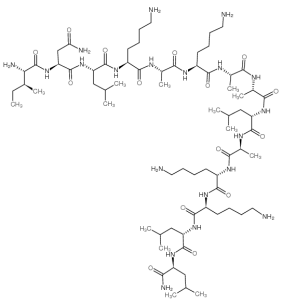Active ingredients of bee venom
Mellitin is the main active component of bee venom. Bee venom is an aromatic, transparent venom derived from the venom glands and accessory glands of worker bees and released by stings when threatened. There are many types of components in bee venom, among which bee venoms have the highest content, accounting for about 50% of dry bee venomous, and its biological activity is very strong. Melittin is composed of 26 amino acids, which is a linear peptide structure with 2849 amino acids. The sequence of amino acids is GIGAVLKVLTTGLPALISWIKRKRQQ-NH2. Modern pharmacological studieshave found that bee venom not only has anti-inflammatory and analgesic effects, but also inhibits platelet aggregation and fights AIDS. It has a strong killing effect on many tumor cells through a variety of mechanisms, and is an anti-tumor natural drug with high application potential.
Antibacterial and antiviral functions
Bee peptides inhibit the growth of more than 20 Gram-positive and negative bacteria and enhance the antibacterial effects of sulfonamides and penicillins. Bee toxins achieve the effect of bactericidal by binding to bacterial membranes and destroying their cell membranes. In addition, melittin and its six derivatives can change the function of HIV-infected T gonorrhea cells, inhibit the replication of HIV, reduce the ability of virus infection.
Anti-tumor effects
1. Multiple in vitro experiments have shown that bee venoms have a significant killing effect on multiple tumor cell lines such as osteosarcoma, ovarian cancer, and glioma, and this effect is positively related to the dose. Bee toxins are effective at killing tumor cells and inhibiting their growth while having little or no noticeable effect on the growth of normal cells. The study found that bee toxin was able to insert into the cell membranes of K562 cells and form pores, thereby promoting the inflow of Ca2 +, leading to an increase in intracellular Ca2 + concentration, ultimately leading to cell cleavage, directly killing K562 units. In addition, melittin can inhibit the normal work of breathing, and destroy the ability of aerobic respiration, thus effectively inhibit the growth of cancer tissue.
2. Cell immunity in immunomodulatory action is an important line of defense against tumors and viral infections in the body. In the process of tumor formation and development, the state of cellular immune function of the body is critical. Boosting cellular immune function can play a certain anti-tumor effect.
3. Inducing the apoptosis of the tumor cells. Apoptosis, also known as programmed cell death, is an active biological process that is regulated by a variety of genes. Because apoptosis is an active process, it involves functions such as the activation, expression and regulation of a range of genes. Modern research has shown that many chemotherapy drugs are able to achieve therapeutic effects by inducing the apoptosis of cancer cells, so inducing apoptosis has become an important criterion for screening anti-cancer drugs.

Treatment methods for rheumatoid arthritis
1. Inhibiting the activity of secretory phospholipase A2 (sPLA2) is of great significance to living organisms, as sPLA2 plays a wide range of roles in infections, injuries, inflammations, and cancers. Studies have shown that apitoxin can effectively inhibit the activity of sPLA2 from various sources, achieving an inhibition rate of up to 96% in the synovial fluid of patients with rheumatoid arthritis (RA). Therefore, using apitoxin may help slow down the progression of RA.
2. Inhibiting the Membrane Attack Complex (MAC) sub-dose of apitoxin can significantly reduce the complement-mediated lysis of cells. This protective mechanism may be related to apitoxin's promotion of intracellular calcium ion (Ca2+) influx, activation of intracellular signaling pathways, and enhancement of the synthesis of protective proteins. These findings suggest that the appropriate use of apitoxin may have a certain clinical value in the treatment of rheumatoid arthritis (RA). Recent research has shown that different concentrations of apitoxin can influence cellular function through various pathways, resulting in a variety of biological effects. The rational application of apitoxin may provide new therapeutic strategies for certain diseases.
Biological activity
Mellitin, an activator of phospholipase A2 (PLA2), can enhance the activity of low-molecular-weight PLA2 but has no effect on the activity of high-molecular-weight enzymes.
Post time: 2025-08-06
